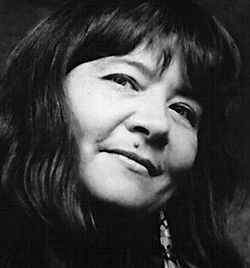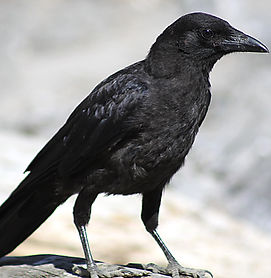
Native American Literature Anthology 2.0
Sara Downs
Leslie Silko
Leslie Silko's writing is greatly influenced by southwest landscape and her exploration of said landscape. She was born in New Mexico and is apart of the Laguna Pueblo tribe. She's published multiple works of literature including collections of poetry, short stories, essays, and an autobiography.

1



The Time We Climbed Snake Mountain
Seeing good places
for my hands
I grab the warm parts of the cliff
and I feel the mountain as I climb.
Somewhere around here
yellow spotted snake is sleeping on his rock
in the sun.
So
please, i tell them
watch out,
don't step on the spotted yellow snake.
he lives here.
The mountain is his.
In Leslie Silko's "The Time We Climbed Snake Mountain" the narrator tells us about a mountain climb. It opens with the a scene of a climber looking for the perfect place to put his hands. The climber must be careful of the yellow spotted snake that dwells on the mountain. The narrator is quick to tell the reader that humans must respect the wildlife on the mountain. The animals were on the mountain first, afterall. We are invading their space with our recreational habbits. Visually, this poem also emodies the snake. The lines move back and forth, like a snakes body does when it slithers. It gives the poem the depth it needs to make a statement.
I liked this poem because I read it after I had gotten back from climbing a mountain in Arizona. When I was there, signs were always telling people to be cautious of wildlife and to respect it. We wer on their land. We were invading their home. It also made me think that in Arizona there's a problem with cyotoes picking up domestic animals as meals. It's because Phoenix and the surrounding suburbs keep expanding, forcing the animals out of their natural habitats. As a society, we can't keep expanding without expecting the animals to "rebel" against us. They were here first. This is their home. This poem could serve as a good PSA against urban and suburban expansion.
Crow Law
The temple where crow worships
walks forward in tall, black grass.
Betrayal is crow's way of saying grace
to the wolf
so it can eat
what is left
when blood is on the ground,
until you see the remains of the moose
is crow
walking out
the sacred temple of ribs
in a dance of leaving
the red tracks of scarce and private gods.
It is the oldest war
where moose becomes wolf and crow,
where the roads ceases
to become the old forest
where crow is calling,
where we are still afraid.
In "Crow Law" Silko uses the crow as a symbol of white assimilation. The crow acts as a friend to the animals, but is also the first one on the scene once the animals die. It eats the flesh and walks around on the carcass with any respect for the deceased. This is similar to the way the white man acted towards the Indians. The government agreed to give them freedom and land, yet went back on their promise as soon as it was inconvienent for them. They committed genocide against a group of people and gave little respect to the dead. The crow leaves red tracks on the ground after eating it's fill. The white man left tracks of blood behind them after fullfilling their blood lust.
"Where the moose becomes wolf and crow" depicts the Indians urge to assimilate. They want to be the crow in fear of being betrayed by the crow. The more they look and act like the crow, the more it will accept them. Their own identity is struggling to survive because they are worried about assimilation and ignorning/forgetting tradition. The crow is calling. The white man is calling, "you're either with us or against us". They are still afraid. The Native Americans are still afraid of the white man. They can't forget what happened to their ancestors. It could easily happen again. They could also be afraid of losing their identity. They want so badly to be proud of who they are, but it's hard to own it while being afraid of death.
I liked this poem because of Silko's use of metaphors. It's so cleverly written and it took me a while to finally grasp what she was trying to convey to the reader. The use of the crow is good too because no one likes crow and they easily fly under the radar. This is similar to the white man. The other animals are quick to trust/ignore the crow, but it comes back to bite them in the end. This is similar to all the land acts and treaties the government broke with Native Americans throughout history. I like when a poem is more than what it first initially seems.

